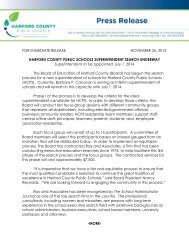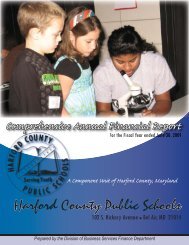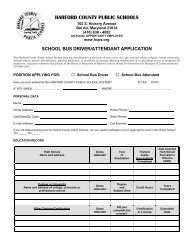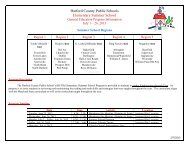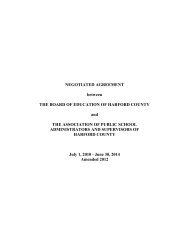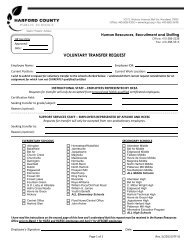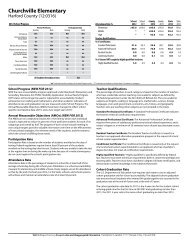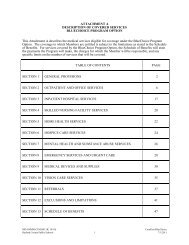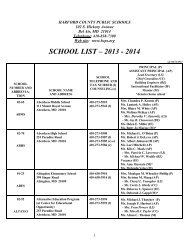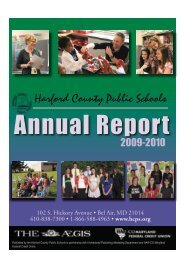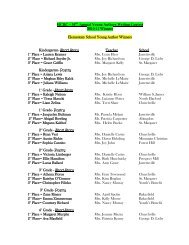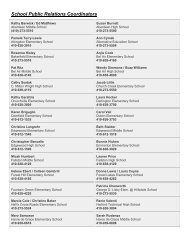Successmaker Enterprise Software Purchase - Harford County ...
Successmaker Enterprise Software Purchase - Harford County ...
Successmaker Enterprise Software Purchase - Harford County ...
Create successful ePaper yourself
Turn your PDF publications into a flip-book with our unique Google optimized e-Paper software.
<strong>Harford</strong> <strong>County</strong> Public Schools – State Discretionary Grant – HSA FY10<br />
Integration with Educational Reform<br />
Under No Child Left Behind, each state has developed and implemented measurements for determining whether its<br />
schools and local educational agencies (LEAs) are making adequate yearly progress (AYP). AYP is an individual state's<br />
measure of progress toward the goal of 100 percent of students achieving to state academic standards in at least<br />
reading/language arts and math. It sets the minimum level of proficiency that the state, its school districts, and schools<br />
must achieve each year on annual tests and related academic indicators. Maryland has established standards for<br />
schools that serve as the context for school improvement. School progress toward the attainment of Maryland content<br />
standards is measured by MSA in grades 3 through 8 and by HSA in high school. HSA assesses students after they<br />
have completed selected courses – Algebra/Data Analysis, English, Government and Biology. The gap between the<br />
state standards and current achievement on these assessments provides the direction for school improvement.<br />
The Vision of <strong>Harford</strong> <strong>County</strong> Public Schools System provides the context for the system’s Master Plan. The Vision<br />
states: <strong>Harford</strong> <strong>County</strong> is a community of learners where educating everyone takes everyone. All students are<br />
empowered to contribute to a diverse, democratic and change-oriented society. <strong>Harford</strong> <strong>County</strong> Public Schools (HCPS)<br />
Master Plan is further aligned with the Mission of the school system: to foster a quality educational system that<br />
challenges students to develop knowledge and skills and inspires them to become life-long learners and good citizens.<br />
The Master Plan systematically addresses the four Board Goals:<br />
To ensure a safe and positive learning environment;<br />
To improve student achievement and close the minority achievement gap;<br />
To ensure the effective use of all resources; and<br />
To provide a high-quality workforce.<br />
This initiative aligns with federal, state and local requirements, educational priorities and school improvement plans.<br />
Annual data from the state assessments provides schools a snapshot of where students are at a single point in time.<br />
Daily instruction continues between when the tests are given and when the results are returned to schools. Teachers<br />
must know on a day to day basis where their students are in relation to the content standards to have the necessary<br />
information to inform instruction. This on-going monitoring is also the way teachers determine whether their instructional<br />
strategies are working for all students and which students need instructional interventions. Regular examinations of<br />
student performance on assignments and assessments enable teachers to make informed instructional decisions<br />
regarding teaching and re-teaching specific indicators/objectives. It is probably obvious, though not always practiced,<br />
that classroom instruction and assessment must be aligned with the state's content standards if a school wishes to attain<br />
state standards and meet their AYP target.<br />
Understanding the relationship between classroom instruction and student achievement is a prerequisite to clarifying the<br />
problem. Improved student achievement is based in large part on good alignment of instruction with the content<br />
standards and on knowing where each student is in relation to the indicators. Consequently, focusing the collection of<br />
data on what teachers need to know and do to align their instruction and understand where their students are in relation<br />
to the indicators/objectives they are expected to teach will produce the most useful information.<br />
Mortimore and Sammons (1987) found that teaching had 6 to 10 times as much impact on achievement as all other<br />
factors combined. Allen Odden and his colleagues conclude that ―improved classroom instruction is the prime factor to<br />
produce student achievement gains‖ (Odden & Wallace, 2003)<br />
The overall goal of the grant initiative is to promote maximum achievement for all students by combining the best<br />
principles of classroom management, peer assisted learning, and differentiated instruction into a comprehensive system<br />
focusing on accountability, measurable achievement, and improved access to the general education curriculum for<br />
diverse learners. Changing instructional practice is at the heart of improving learning outcomes for underserved and<br />
19



